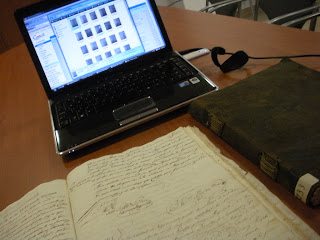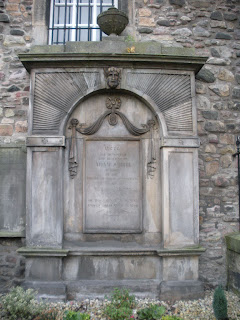
In an effort to explain just what I’m doing in Spain, I thought it might be interesting to show a few photos from the archives. In addition to archives in the city of Sevilla, I have been traveling to others located in neigh
 boring towns. The building in the picture at right offers a good example of what these look like. This particular building, a former residence, houses both the municipal library of Carmona and its archive, the Archivo Municipal de Carmona (AMC). On a busy day, the archivist at the AMC can expect about three to four visitors. Of course, I have spent days in archives of this sort where I was the only visitor. Though the majority of visitors are professional scholars, it not unusual for such archives also receive architects and engineers pursuing restoration work and representatives from the ayuntamiento (municipal government) in search of town records. Technically part of the ayuntamiento, the municipal archive serves as the depository for the town’s records, including documents like the actas capitulares (minutes) of the cabildo (town council).
boring towns. The building in the picture at right offers a good example of what these look like. This particular building, a former residence, houses both the municipal library of Carmona and its archive, the Archivo Municipal de Carmona (AMC). On a busy day, the archivist at the AMC can expect about three to four visitors. Of course, I have spent days in archives of this sort where I was the only visitor. Though the majority of visitors are professional scholars, it not unusual for such archives also receive architects and engineers pursuing restoration work and representatives from the ayuntamiento (municipal government) in search of town records. Technically part of the ayuntamiento, the municipal archive serves as the depository for the town’s records, including documents like the actas capitulares (minutes) of the cabildo (town council).
The contents of every archive are cataloged by a number of standardized sections: gobierno (government), secretaría (administra

Consulting original documents is a key part to the writing of history in order to help separate fact from fiction – at least to the extent that is possible based on the quality of source mat
erial. As a graduate dissertations are intended to comprise an original contribution to the field, in most cases this means no prior individual has pursued the same line of inquiry. Even when something is not all that new, this process of review also serves as an important means to validate the work of prior historians. In my case, viewing original election tallies (like that at right) and letters of petition help to reconstruct the political life of a town.
Most of the documents pertaining to the time period of my research were written, not typed, on stamped paper. That is, contemporaries recorded information on paper bearing an official sello (sta
Reading these documents, I encounter more than a few challenges.
The authors themselves left ink blots, smudges, or may have used a type of ink that lightened with time or corroded the integrity of the paper making it more brittle – in
some cases the inked portion of the paper has disintegrated leaving only the outline of text. It’s often the case that a layer of black sand –residual blotting used to help dry the ink after its application – falls out from between the leaves of paper as I flip through them. Though this sand gives the ink a sparkle, it usually ends up all over my hands. Whatever doesn’t make it onto my hands covers my immediate workspace. Beyond these concerns exists an array of conservation problems. The years have not always been kind to these documents. Some papers are littered with water stains, mold marks, and in some cases are even worm eaten. In addition, to these physical characteristics, I run across a number of linguistic challenges that pertain to my own abilities as a scholar of the Spanish language.
Deciphering text in the documents that I have consulted has been an interesting task. Of course, just reading another’s handwriting is a challenge. The word de (of) is often written more as a stylized squiggle particular to each individual than something possessing the letters D or E. Adding to this challenge, the Spanish use the vosotros verb tense (second person, plural) in a way Mexicans and other Latin Americans do not. This applies to both formal and informal communications. Hence, a royal decree might include the command “SABED” (Let it be known that...). Abbreviations also prove hard to tackle at times. For instance, it took me more than a week to realize the abbreviation “dho.” was contemporary shorthand for dicho (said). I was somewhat quicker to discern the use of superscript letters for names, “Ma.” in place of Maria and “Ferndo.” in place of Fernando.
Ultimately, in the rather brief time I have with each document, I have to judge whether something is of value and debate how long and complete of a note to take. Ultimately, I most often choose to capture a photo and keep moving. In general, that’s my motto, keep moving. I have a lot of files to cover between now and next June.























